Novartis Bundle
Can Novartis Conquer the Future of Healthcare?
Novartis, a titan in the pharmaceutical industry, has consistently demonstrated the crucial role of a strong growth strategy. From its inception, marked by the transformative merger of Ciba-Geigy and Sandoz, the company has been on a mission to accelerate innovation and expand its global footprint. Today, Novartis stands as a leading global healthcare provider, making it a compelling subject for Novartis SWOT Analysis.
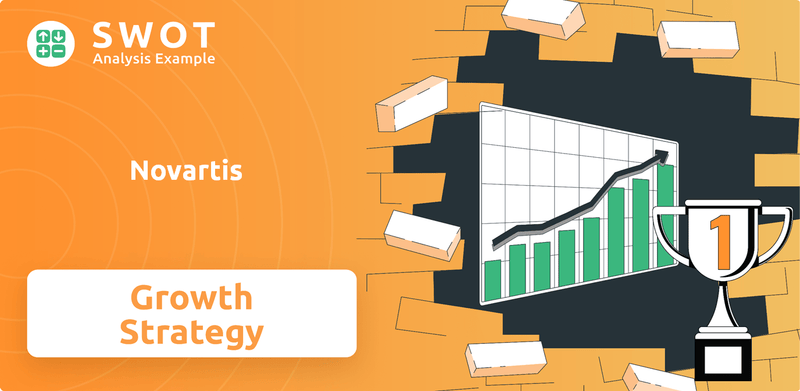
This analysis delves into the Novartis growth strategy, examining its evolution from a diversified entity to a 'pure-play' innovative medicines business. We will explore the company's strategic initiatives in 2024, its market share analysis, and the impact of pharmaceutical industry trends. Furthermore, this exploration will also cover the Novartis business model, its drug development pipeline, and the company's future prospects in a rapidly evolving healthcare landscape, including its expansion plans in emerging markets.
How Is Novartis Expanding Its Reach?
The expansion initiatives of Novartis are multifaceted, focusing on geographical growth, product pipeline advancements, and strategic investments. These efforts are designed to capitalize on market opportunities and solidify its position within the pharmaceutical industry. The company's strategic approach includes significant investments in manufacturing, research and development (R&D), and new market entries.
Novartis is actively working on expanding its business through various initiatives. These include focusing on new markets, product launches, and strategic investments. A central aspect of this expansion is the planned $23 billion investment over five years, starting in 2025, to boost its manufacturing and R&D footprint in the United States. This commitment aims to ensure that a significant portion of key medicines for US patients will be produced domestically, significantly increasing current levels.
These initiatives are driven by the need to localize production, diversify revenue streams, and adapt to industry changes. This aligns with a projected compound annual growth rate (CAGR) of over 6% between 2023 and 2028, indicating positive expectations for the future. The company's strategic investments and focus on key markets highlight its commitment to long-term growth and innovation.
Novartis is emphasizing growth in East Asian markets, with China showing significant sales growth. The company is also expanding its presence in Slovenia, with investments exceeding 3 billion Euros since 2003, focusing on development and modernization of production capacities. These expansions are strategically important for diversifying revenue streams and tapping into new markets.
The company expects eight blockbuster drugs to generate over $3 billion in peak sales each. Novartis is focusing on a streamlined portfolio to drive sales, with over 30 potentially high-value new molecular entity (NME) candidates in clinical Phases I-III. Key growth drivers include therapies like Entresto, Kesimpta, and Kisqali, showing strong sales growth in recent quarters.
Novartis plans to invest $23 billion over five years in its US-based manufacturing and R&D. This includes establishing a new biomedical research innovation hub in San Diego, California, and building new manufacturing facilities. The acquisition of Kate Biotherapeutics for $1.1 billion in November 2024 strengthens its gene therapy and neuroscience innovation efforts.
Entresto's revenue reached $2.18 billion in Q4 2024, a 34% year-over-year increase, while Kesimpta saw a 49% increase and Kisqali a 52% increase in Q1 2025. Leqvio is on track to become a blockbuster drug, with sales expected to exceed $1 billion in 2025. These figures highlight the company's strong financial performance and positive outlook.
The strategic initiatives of Novartis, including significant investments in R&D and manufacturing, are designed to drive long-term growth. The company's focus on key markets like China and its strong product pipeline, including blockbuster drugs like Entresto, Kesimpta, and Kisqali, position it well for future success. Furthermore, strategic acquisitions such as Kate Biotherapeutics enhance its capabilities in innovative therapies. For a deeper understanding of the competitive landscape, consider exploring the Competitors Landscape of Novartis.
Novartis is making significant investments to expand its operations and product offerings. These efforts are aimed at improving its market position and driving future growth. The company's strategy focuses on both geographical expansion and advancements in its product pipeline.
- $23 billion investment over five years in US manufacturing and R&D.
- Focus on growth in East Asian markets, particularly China.
- Pipeline of eight potential blockbuster drugs.
- Acquisition of Kate Biotherapeutics to boost gene therapy efforts.
Novartis SWOT Analysis
- Complete SWOT Breakdown
- Fully Customizable
- Editable in Excel & Word
- Professional Formatting
- Investor-Ready Format
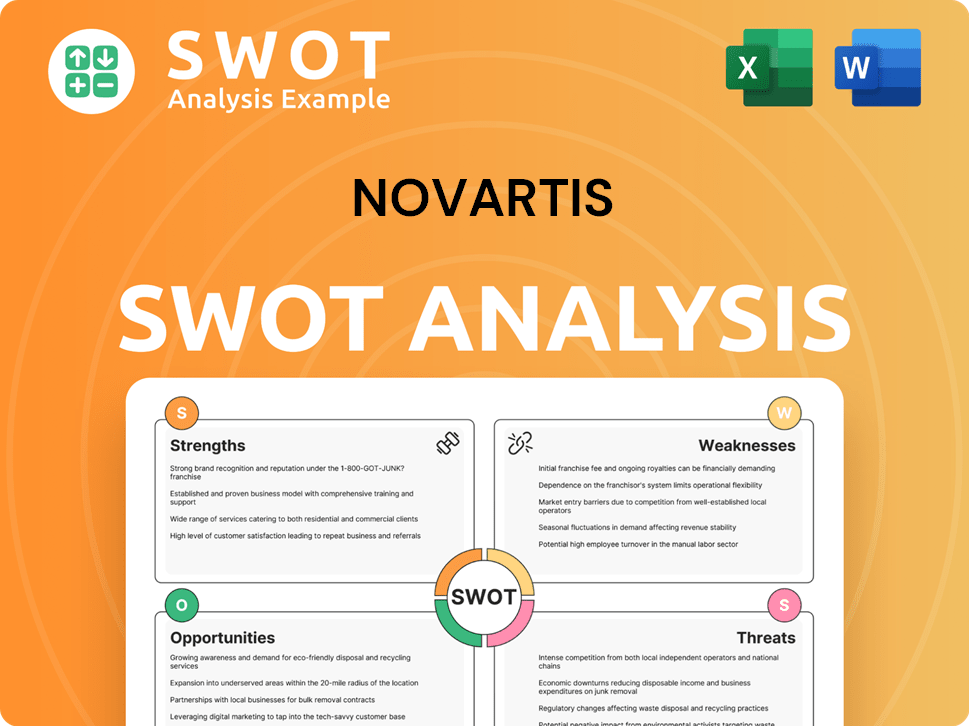
How Does Novartis Invest in Innovation?
The growth strategy of Novartis is heavily reliant on innovation and technology. The company is committed to continuous investment in research and development, as well as scaling up manufacturing across various platforms. This approach is critical for maintaining a competitive edge within the pharmaceutical industry trends.
Novartis is focusing on both established and emerging platforms, including chemistry, biotherapeutics, gene and cell therapy, radioligand therapy, and xRNA. This diversified approach helps to mitigate risks and capitalize on different areas of scientific advancement. The company's strategic initiatives 2024 are designed to drive long-term value creation.
A key aspect of Novartis's strategy is its investment in infrastructure. The company plans to invest $23 billion over five years in US-based infrastructure. This includes a new $1.1 billion biomedical research innovation hub in San Diego, California, which is expected to open between 2028 and 2029. This investment underscores the company's commitment to drug discovery and scientific advancement. For more insights into the company's ownership structure, you can explore Owners & Shareholders of Novartis.
Novartis is actively integrating artificial intelligence (AI) into its research and development processes. This integration is designed to improve efficiency and accelerate drug development. The goal is to streamline operations and enhance the likelihood of success in bringing new therapies to market.
The company is implementing a 'fast-to-IND' strategy for preclinical assets. This strategy aims to accelerate Investigational New Drug (IND) submissions by up to 12 months. Predictive models and secured manufacturing capacities are key components of this strategy.
Novartis has refocused its clinical pipeline to increase investment per project. The company reduced the number of active projects from 155 in Q3 2021 to 94 in Q3 2024. This allows for more focused resource allocation.
Novartis is embracing digital technologies to enhance patient care and operational efficiency. The company is investing in digital capabilities to better connect with patients and healthcare providers. This includes leveraging technology leadership in R&D, commercialization, global access, and data science.
The company is committed to sustainability, with a 67% reduction in Scope 1 and 2 emissions in 2024 compared to 2020 levels. Novartis aims to become carbon neutral in its own operations by 2025. The company is also targeting net-zero emissions across its value chain by 2040.
Novartis is actively working with suppliers to decarbonize healthcare delivery. In 2024, 76% of supplier emissions were covered by contracts that included environmental sustainability criteria. This collaborative approach is critical for achieving broader sustainability goals.
Novartis's strategic initiatives are centered around innovation, digital transformation, and sustainability. These efforts are designed to drive long-term growth and enhance the company's competitive position. The company's focus on its drug development pipeline and market share analysis are crucial for its future prospects.
- Prioritizing R&D investments in new technologies.
- Accelerating drug development through AI and fast-to-IND strategies.
- Enhancing patient care and operational efficiency with digital technologies.
- Reducing emissions and promoting sustainability across the value chain.
- Collaborating with suppliers to decarbonize healthcare delivery.
Novartis PESTLE Analysis
- Covers All 6 PESTLE Categories
- No Research Needed – Save Hours of Work
- Built by Experts, Trusted by Consultants
- Instant Download, Ready to Use
- 100% Editable, Fully Customizable
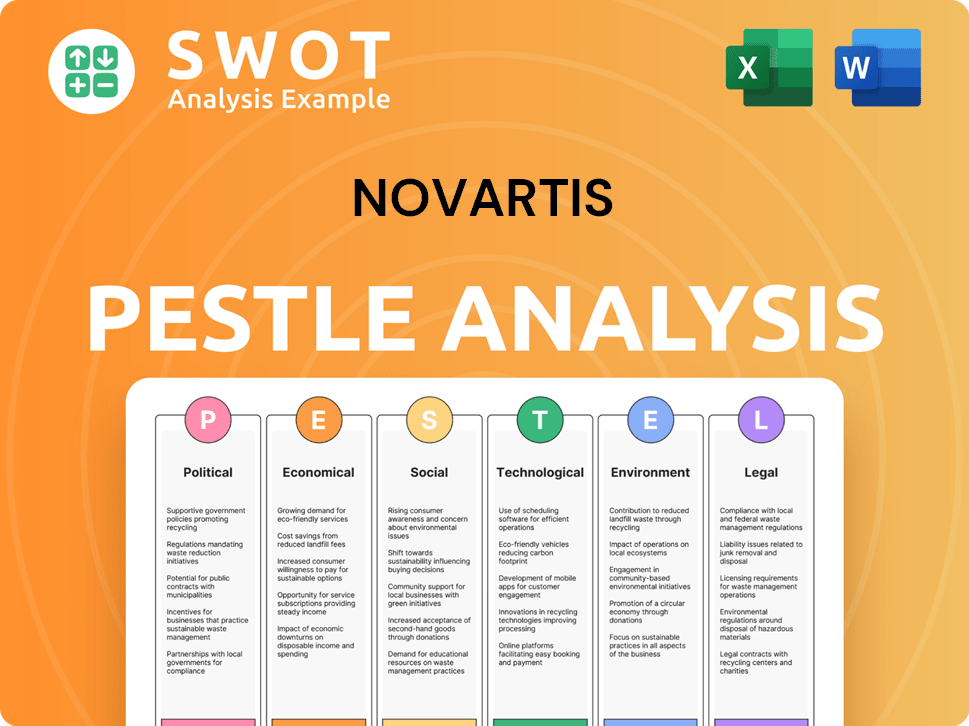
What Is Novartis’s Growth Forecast?
Novartis has shown robust financial results and anticipates continued growth. The company's financial performance reflects its strong position in the pharmaceutical industry. This positive trajectory is supported by strategic initiatives and a focus on innovative therapies, contributing to its overall Novartis growth strategy.
For the full year 2024, Novartis reported net sales of $50.32 billion, a 12% year-on-year increase, and core operating income jumped 19% to $19.50 billion. The company's net income for 2024 was $11.9 billion. These figures highlight the company's strong financial health and operational efficiency, which are key aspects of any Novartis company analysis.
In Q4 2024, net sales grew by 16% year-over-year at constant currency, reaching $13.15 billion, with core operating income increasing 29% to $4.86 billion. Free cash flow surged 70% year-over-year to $3.64 billion in Q4 2024. This financial performance underscores Novartis's ability to generate substantial cash flow, supporting its investments in research and development and strategic initiatives.
Looking ahead to 2025, Novartis expects net sales to grow in the mid- to high-single digits. The company anticipates core operating income to grow in the high single to low double-digit range. This positive outlook reflects the company's confidence in its pipeline and market position.
Following a strong Q1 2025 performance, with revenue up 12% to $13.2 billion and net income jumping 34% to $3.6 billion, Novartis raised its full-year 2025 guidance. The company now projects high-single-digit sales growth and low-double-digit core operating income growth. This demonstrates the effectiveness of its Novartis business model.
The company's earnings per share (EPS) for Q1 2025 was $2.28, beating estimates. For the full fiscal year 2025, the consensus EPS forecast is $8.74, with expectations of growth to $8.81 per share in the next year, a 4.26% increase. This positive EPS outlook is a key indicator for investors.
Novartis is committed to shareholder returns, proposing a 6.1% dividend increase to CHF 3.50 per share for 2024, marking the 27th consecutive year of dividend increases. In 2024, the company repurchased 77.5 million shares for $8.3 billion. This commitment to shareholder value is a key component of its financial strategy.
Novartis maintains a strong financial position, supported by a current ratio of approximately 1.04, indicating a healthy short-term financial position, and a debt-to-equity ratio of 0.71, suggesting a balanced financial structure. These metrics reflect the company's ability to manage its financial obligations effectively.
- Net Sales (2024): $50.32 billion, up 12% year-on-year.
- Core Operating Income (2024): $19.50 billion, up 19%.
- Net Income (2024): $11.9 billion.
- Q1 2025 Revenue: $13.2 billion, up 12%.
- Q1 2025 Net Income: $3.6 billion, up 34%.
The company's strong financial performance is also supported by its focus on research and development, which is crucial in the pharmaceutical industry. For more insights into the company's origins and evolution, you can read a brief history of Novartis.
Novartis Business Model Canvas
- Complete 9-Block Business Model Canvas
- Effortlessly Communicate Your Business Strategy
- Investor-Ready BMC Format
- 100% Editable and Customizable
- Clear and Structured Layout
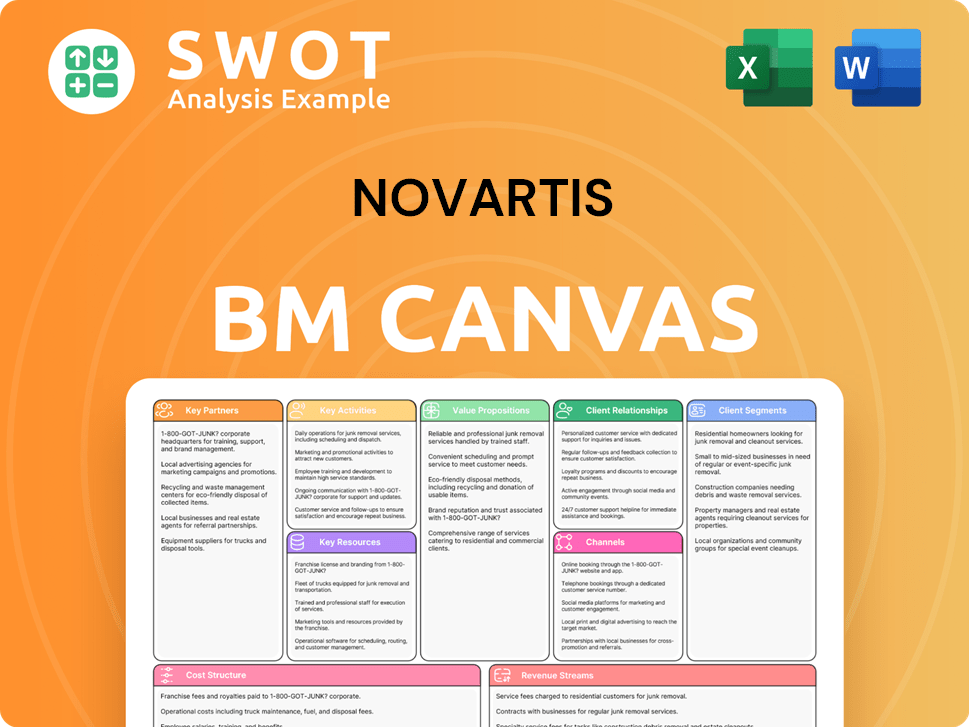
What Risks Could Slow Novartis’s Growth?
The path to growth for Novartis is not without its challenges. The company faces several strategic and operational risks that could impact its future. Understanding these potential obstacles is crucial for a comprehensive Novartis company analysis and evaluating its Novartis future prospects.
One of the primary concerns for Novartis is the increasing competition from generic drugs. The loss of exclusivity for major revenue-generating drugs starting in 2025 poses a significant threat to the company's revenue stream. This could lead to a decline in market share and pricing power, affecting both top-line revenue and gross margins.
Medical innovation inherently involves risks, including setbacks in research and development (R&D), unfavorable clinical trial outcomes, or delays in regulatory approvals. These factors can significantly impact Novartis's drug development pipeline and overall growth trajectory. Mission, Vision & Core Values of Novartis highlights the company's commitment to innovation, but also acknowledges the inherent risks involved.
The impending loss of exclusivity for key drugs like Entresto, Promacta, and Tasigna in 2025 will expose the company to generic competition. This shift could lead to a rapid erosion of market share and pricing power, directly impacting the revenue stream. The pharmaceutical industry trends show that this is a common challenge.
Setbacks in the drug development pipeline, including unfavorable clinical trial outcomes and delays in regulatory approvals, can significantly impact the company's growth. Some medications have faced challenges in drug trials, encountered safety problems, or experienced delays. These risks are inherent in the Novartis business model.
Large acquisitions, like the acquisition of Anthos Therapeutics, carry integration risks. Successfully merging new operations and ensuring milestone payments materialize are crucial for realizing the expected benefits. The success of the acquisition hinges on effective integration.
Regulatory challenges and pricing pressures in global markets, particularly in Europe, present significant obstacles. CEO Vas Narasimhan has expressed concerns about price controls and austerity measures in the EU, impacting investment attractiveness. These factors influence Novartis market share analysis.
Supply chain vulnerabilities pose another potential risk, although Novartis's $23 billion investment in US-based manufacturing aims to localize production. This investment is designed to mitigate some of these supply chain risks. The company is actively working to address these challenges.
The pharmaceutical industry is highly competitive, with evolving treatment paradigms. Staying ahead of competitors requires continuous innovation and strategic agility. Novartis must navigate this competitive landscape effectively to maintain its market position.
Novartis addresses these risks through diversification, focusing on its core therapeutic areas and a robust pipeline. The company is proactively addressing generic threats by prioritizing the growth of current brands and new product launches to offset potential losses. This is a key element of the Novartis growth strategy.
Novartis's management emphasizes its preparedness for shifts in the external environment and confidence in its guidance, indicating a proactive risk management approach. This includes anticipating and preparing for patent expirations and other market changes. This is a critical component of Novartis's strategic initiatives 2024.
Novartis Porter's Five Forces Analysis
- Covers All 5 Competitive Forces in Detail
- Structured for Consultants, Students, and Founders
- 100% Editable in Microsoft Word & Excel
- Instant Digital Download – Use Immediately
- Compatible with Mac & PC – Fully Unlocked
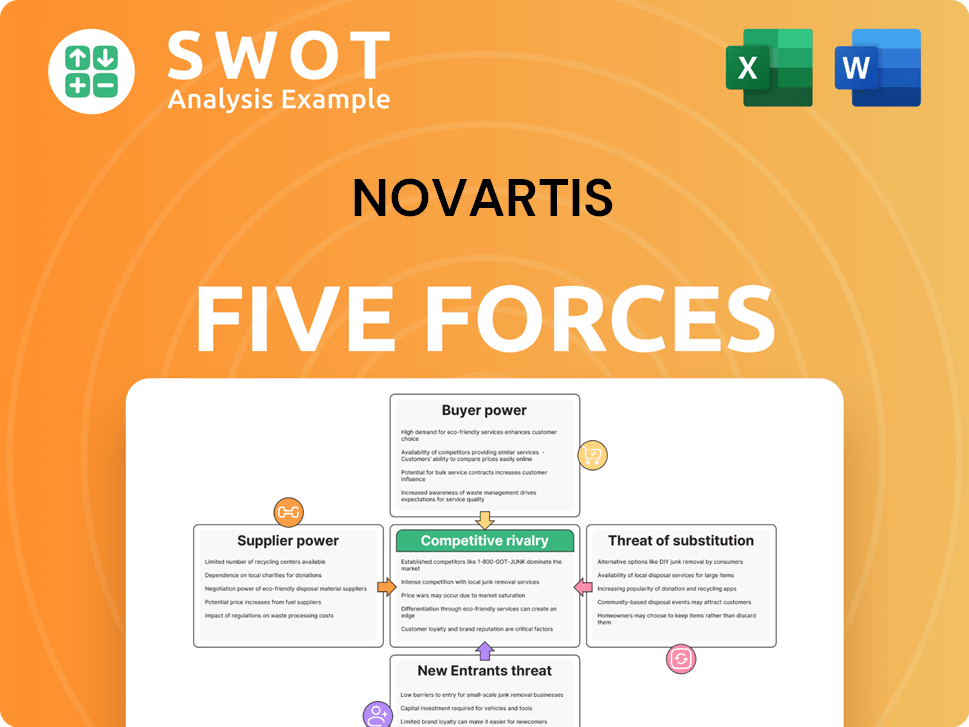
Related Blogs
- What are Mission Vision & Core Values of Novartis Company?
- What is Competitive Landscape of Novartis Company?
- How Does Novartis Company Work?
- What is Sales and Marketing Strategy of Novartis Company?
- What is Brief History of Novartis Company?
- Who Owns Novartis Company?
- What is Customer Demographics and Target Market of Novartis Company?
Disclaimer
All information, articles, and product details provided on this website are for general informational and educational purposes only. We do not claim any ownership over, nor do we intend to infringe upon, any trademarks, copyrights, logos, brand names, or other intellectual property mentioned or depicted on this site. Such intellectual property remains the property of its respective owners, and any references here are made solely for identification or informational purposes, without implying any affiliation, endorsement, or partnership.
We make no representations or warranties, express or implied, regarding the accuracy, completeness, or suitability of any content or products presented. Nothing on this website should be construed as legal, tax, investment, financial, medical, or other professional advice. In addition, no part of this site—including articles or product references—constitutes a solicitation, recommendation, endorsement, advertisement, or offer to buy or sell any securities, franchises, or other financial instruments, particularly in jurisdictions where such activity would be unlawful.
All content is of a general nature and may not address the specific circumstances of any individual or entity. It is not a substitute for professional advice or services. Any actions you take based on the information provided here are strictly at your own risk. You accept full responsibility for any decisions or outcomes arising from your use of this website and agree to release us from any liability in connection with your use of, or reliance upon, the content or products found herein.